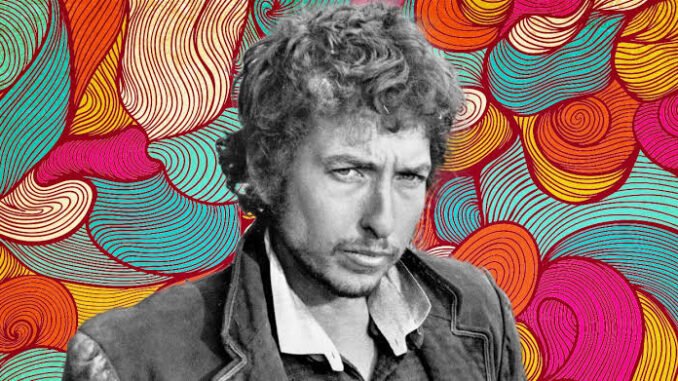
Bob Dylan portrayed in A Complete Unknown, expecting to see Jeremy Allen White as Bruce Springsteen, and Julia Garner as Madonna. The sheer frequency of these releases raises a suspicion that these movies are not necessarily serving the legacy of the musical artists in question. Instead, biopics are starting to feel more like…
Acknowledging these parts of Dylan’s musical catalog that feel like anomalies is so important because, without them, an audience can’t possibly gain a true understanding of the musical artist in question. Being able to connect certain records with a significant personal story in another period of a musician’s life is what understanding the legacy is really about. So let’s get on and understand the remaining three Dylans.
The fourth Dylan, Robbie Clark (Heath Ledger), is most akin to the Dylan that Timothée Chalamet took on for A Complete Unknown. This is the era of distasteful relationship choices in the rise to fame. Think of the album cover for The Freewheelin’ Of Bob Dylan featuring an image of him and his then-girlfriend Suze Rotolo arm in arm. The record featured the song “Honey, Just Allow Me One More Chance,” which gives enough of a hint about what Dylan was up to at that time.
The fifth is undoubtedly the best version of Dylan in this movie. Played by Cate Blanchett, the character of Jude Quinn is the most cannily Bob Dylan, and follows him through his controversial transition to electronic amplification. His bad boy era. Growing tired of acoustic songs, Dylan made shock waves at the 1965 New England Folk Festival with electric guitars, and continued the commotion in the following UK tour. Jude Quinn breaks the pretense of hiding Dylan’s identity by speaking direct quotes from Dylan. This includes the famous response to being asked if he cares what he sings every night, to which he retaliates, “How can I answer that if you’ve got the nerve to ask me?” Dylan was refusing to define his work and show any signs of creative vulnerability, and in this time, released an insane run of albums, including Blonde On Blonde.
Lastly, there is the character of Billy the Kid (Richard Gere). In his real life, Dylan hid from the public for quite some time after the electric period, seemingly unable to shake the folk off. He also experienced a bad road accident that put him in the limelight for a while. Billy fights the town over not approving of a highway being built, reflecting an inability to accept modernity. Billy is thrown in jail, but escapes onto a cargo train. Here, he finds the guitar of Woody Guthrie. It’s a full-circle moment that encapsulates the folk soul of Bob Dylan that never betrayed him through his adventures.
I’m Not There begins with the character of a young boy on the run from home, on a train with just his guitar and the clothes on his back. This boy, Woody Guthrie (Marcus Carl Franklin), gives the audience an insight into the blues music Dylan appreciated growing up with. The real-life Guthrie was an American Folk legend, showing how Dylan’s musical roots were always in folk, whose musical roots are in blues. After a few scenes of him, the movie cuts to the narrator figure of the movie, named Arthur Rimbaud (Ben Whishaw). This character is a recognizable caricature of Dylan, with his electrified hair and defined cheekbones and the first insight we get to Dylan’s (more) adult mind. The real-life Rimbaud was a wonderful French poet who had a transgressive approach to social issues. This reveals to the audience Dylan’s navigator for writing such beautiful and poetic lyrics to accompany his folk tunes.
Things get a little more complicated with the third version of Dylan, as his story line involves a reinvention of his own. We first know Dylan-number-three as Jack Collins (Christian Bale), a social warrior who doesn’t shy away from confrontational themes in his music to challenge society. This musical period is what was known as Dylan’s “finger-point” songs, which actually “Like A Rolling Stone” falls into. Within Jack’s story, tired of fighting for social justice, he has an epiphany of acceptance and is reborn as Pastor John. It’s easy to forget that Dylan had a quick gospel phase, but this story covers the context behind records like Saved that Dylan released and confused his fan base with.
Part of Bob Dylan’s legacy is the fact that he’s so elusive. He’s an enigmatic guy, a tortured poet who’s quite frankly too cool to give away too much information about himself outside his songs. This is why the indirect referencing to Bob Dylan is so genius by Haynes. He acknowledges the notion of Dylan’s mystery and pays the perfect tribute to it with a refracted sense of legacy, rather than the overcompensated snapshot of A Complete Unknown.
The movie gives six representations of Dylan, and it’s worth noting that the names of these characters are often named after real-life people. These people are key influences on Dylan from the real world, and to blend the fictitious world and the real world is incredibly smart from Haynes. It is a crucial decision that reflects how musical personas are never really real. They are crafted from stories and influences to display music through a curated channel.
Leave a Reply